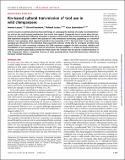Kin-based cultural transmission of tool use in wild chimpanzees
Abstract
Current research on animal culture has focused strongly on cataloging the diversity of socially transmitted behaviors and on the social learning mechanisms that sustain their spread. Comparably less is known about the persistence of cultural behavior following innovation in groups of wild animals. We present observational data and a field experiment designed to address this question in a wild chimpanzee community, capitalizing on a novel tool behavior, moss-sponging, which appeared naturally in the community in 2011. We found that, 3 years later, moss-sponging was still present in the individuals that acquired the behavior shortly after its emergence and that it had spread further to other community members. Our field experiment suggests that this secondary radiation and consolidation of moss-sponging is the result of transmission through matrilines, in contrast to the previously documented, association-based spread among the initial cohort. We conclude that the spread of cultural behavior in wild chimpanzees follows a sequential structure of initial proximity-based, horizontal transmission, followed by kin-based vertical transmission.
Citation
Lamon , N , Neumann , C , Gruber , T & Zuberbühler , K 2017 , ' Kin-based cultural transmission of tool use in wild chimpanzees ' , Science Advances , vol. 3 , no. 4 , e1602750 . https://doi.org/10.1126/sciadv.1602750
Publication
Science Advances
Status
Peer reviewed
ISSN
2375-2548Type
Journal article
Description
This work was funded by the European Research Council (ERC) under the European Union’s Seventh Framework Programme (FP7/2007-2013)/ERC grant agreement no. 283871 and the Swiss National Science Foundation (SNSF; project 310030_143359 to K.Z.). T.G. was supported by an Interdisciplinary Project grant (CR13I1_162720/1) from the SNSF.Collections
Items in the St Andrews Research Repository are protected by copyright, with all rights reserved, unless otherwise indicated.

